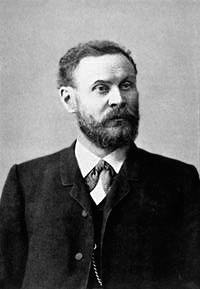Otto Lilienthal
AvStop
Magazine Online
Otto Lilienthal
The Legacy of Lilienthal
To glide is to fly

(1848-1896) |
Before 1881, attempts to develop airplanes and gliders were occasional
and sporadic. Otto Lilienthal changed all that. Indeed, Lilienthal's efforts
broke the 'respectability barrier' that haunted serious efforts to develop
airplanes. Before Lilienthal, building a heavier-than-air craft was widely
considered to be the province of dreamers and fools; afterwords it seemed
possible to fly. Thus, his efforts mark the beginning of the experimental
period of active research on heavier-than-air flight. Lilienthal developed
eighteen different models of his gliders over a span of 5 years.
His efforts received worldwide publicity, and his successes lent others
the courage to follow in his footsteps.
Fifteen of Lilienthal's gliders
were monoplanes, three were biplanes. Each model was a hang glider, controlled
by the pilot shifting his weight rather than through the use of any active
control surfaces. These eighteen craft will be described
separately at some point in the hopefully-not-too-distant future. Lilienthal's
first glider was tailless, little more than a pair of wings.
He tested
this glider by jumping off a board. Lilienthal's experiments were soon
to get more serious, however. He built an artificial conical hill (visible
in the background) at Lichterfelde, near Berlin, so he could launch
his gliders into the wind no matter which direction it was coming from. No. 11 was the 'standard' Lilienthal model, a monoplane with a wing
area of 13 sq. m. At least eight replicas of this model were built, and
either sold or presented to clients. The National Space and Air Museum
in the Smithsonian has a No. 11 built by Lilienthal.
|
Beyond legitimizing attempts to conquer the air, and his effective hang
gliders often copied by others, Lilienthal made two vital contributions
to the invention of the airplane. First, he showed by word and example
that mastery of flight should be first accomplished in gliders. Then, he
provided particular inspiration to the Wright brothers, both through his
successes and through his failures.
Sir Charles Gibbs-Smith divided airplane
inventors into two categories. The first he termed "Chauffeurs
of the Air," because they acted as though flying a plane was like driving
a car. Maxim is the best example of this large category. In contrast, Gibbs-Smith
identified "Airmen" who understood that the fluid medium of air made flight
a quite different proposition than land-based maneuvering. Chauffeurs tended
to be concerned with obtaining sufficient propulsion, without worrying
overmuch about factors like lift or control. Airmen often worked on gliders
before tackling the problem of powered flight. Although Lilienthal was
not the first to work with gliders, his systematic, organized approach,
and his obvious success, defined the prototype "Airman." This example,
followed by Chanute and the Wright brothers, was of tremendous importance
in reducing the problem of inventing the airplane to manageable dimensions.
Indeed, I believe an excellent case can be made that Cayley
was aviation's grandfather, and Lilienthal its uncle. From statements and
writings left by the Wright brothers, it is clear Lilienthal was an important
source of inspiration for their efforts. A case can be made that the writings
of Lilienthal directly inspired the Wrights to take on the invention of
the airplane as an interesting pursuit. Certainly their early framing of
the "problem of flight" was derived largely from Lilienthal's ideas and
difficulties. Echoes from Lilienthal's article Practical
Experiments for the Development of Human Flight are clearly evident
in Wilbur's address to the Western Society
of Engineers, and in his first letter to Octave Chanute.
Lilienthal is the source of two famous quotes about inventing airplanes.
The first illustrates the discipline that must accompany creativity in
invention: "To invent an airplane is nothing. To build one is something.
But to fly is everything." The second was all too prophetic: "Sacrifices
must be made." He died August 10, 1896 from injuries sustained two days
earlier in a crash of one of his hang gliders.
Lilienthal's portrait was copied from one of the Aeronautical Annuals
published by James Means around the turn of the century. The images of
the biplane glider derive from the same source.
